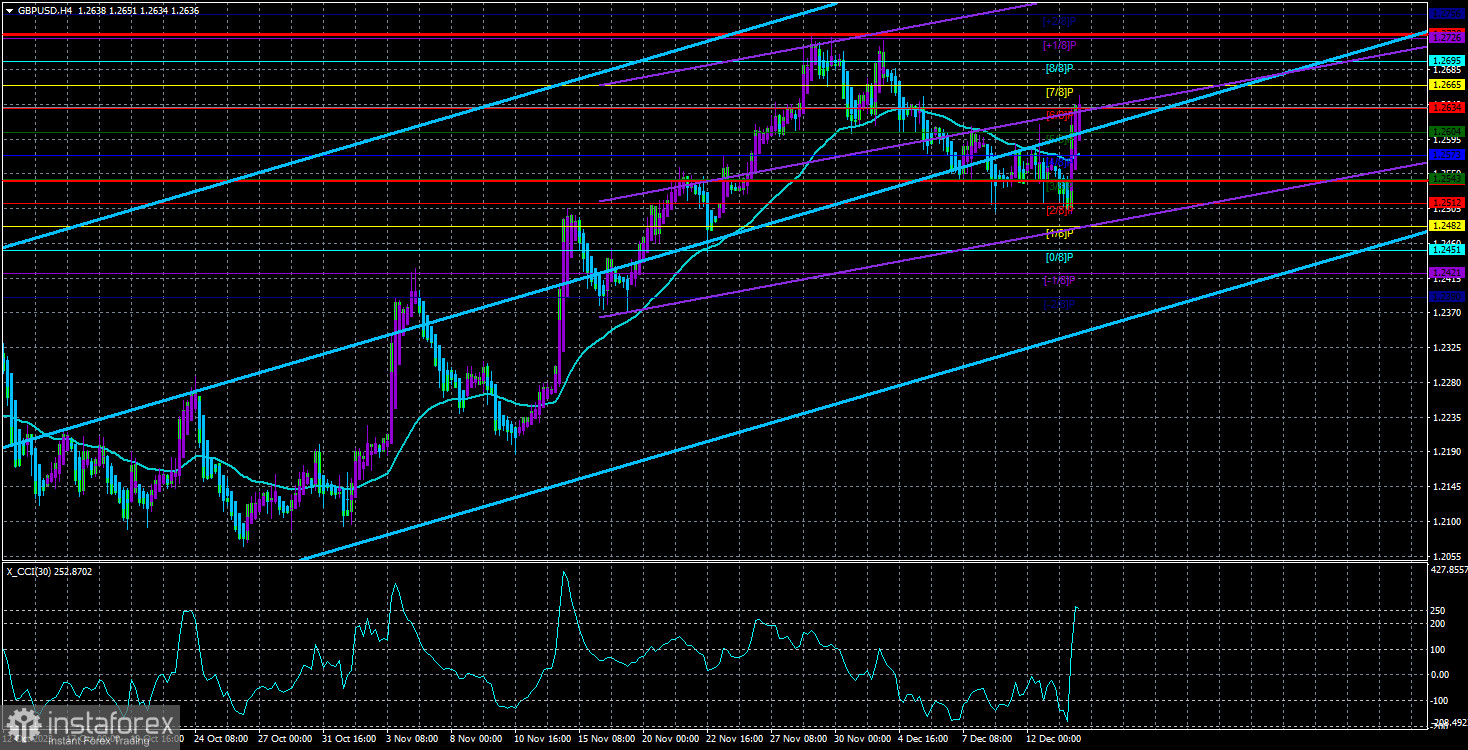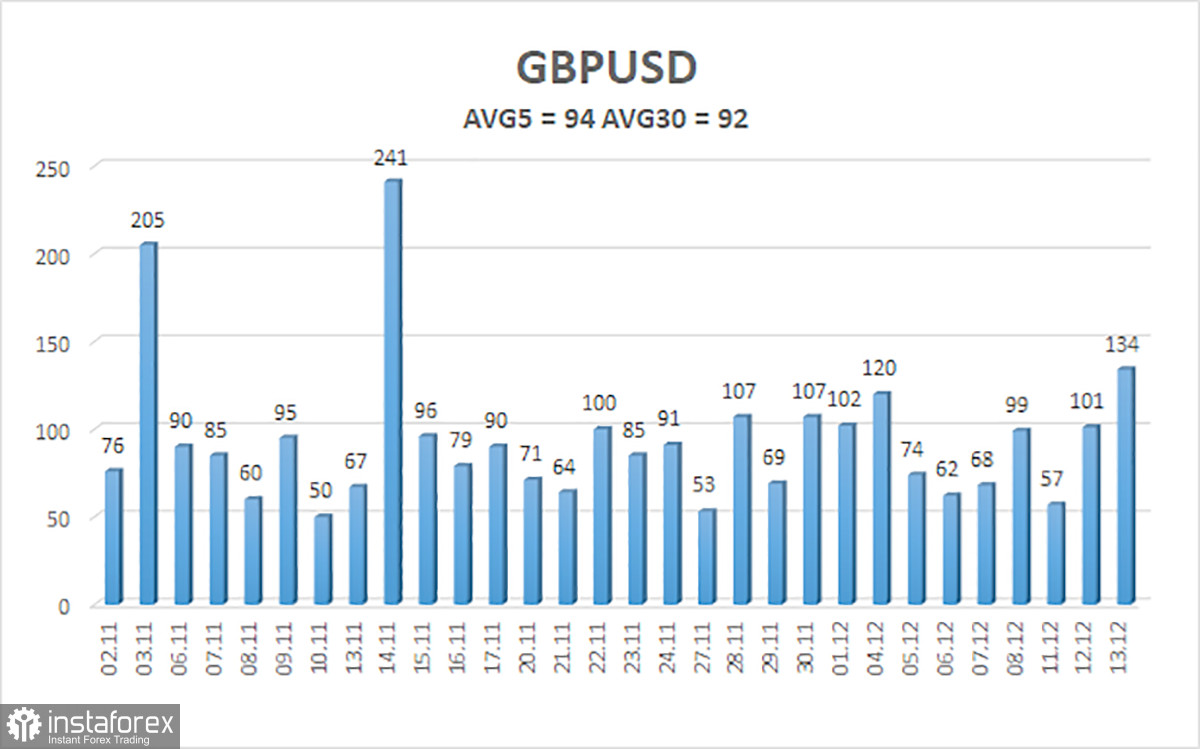
The GBP/USD currency pair also showed quite strong growth on Wednesday, which could well not have happened. Recall that yesterday Jerome Powell stated at a press conference that further rate hikes are unlikely, and next year the regulator may lower the rate three times. These two phrases precisely triggered a sharp decline in the US currency, although there was nothing unexpected in them. The fact that the Fed will lower the rate next year has been known for a long time. The Bank of England will follow the same path, as its GDP continues to fall and risks being significantly below zero in the coming months and quarters. Therefore, the British regulator will also only soften monetary policy. Perhaps it will start doing so a little later than the American regulator.
If all the above is true, then on what grounds does the pound have to rise if its central bank will also lower the rate in 2024? Yes, the market reacted with dollar sales yesterday, but the pound has been rising for two months already. This growth is corrective; the correction must end, and there are simply no long-term reasons for the pound to rise. We continue to believe that the pound should fall, and there are no other logical and justified options.
The technical picture changed yesterday. First, the price settled above the moving average. True, this consolidation means little, as the market traded impulsively and emotionally yesterday evening. Today we can see an even stronger decline in the pair. Second, the CCI indicator, for the fourth time since the end of October, entered the overbought zone. The previous three entries were not worked out properly because a decline of 100-200 points cannot be considered a triple overbought correction. Therefore, as before, we believe that the road for the British currency is only down.
On the 24-hour timeframe, there are currently no specific technical reasons to expect a pair decline. To begin with, it is necessary to consolidate below the critical line. And to consolidate below the Kijun-sen, a price return below the moving average in the 4-hour timeframe is required.
The Bank of England may take a wait-and-see position and support the pound.
The British pound, which once again showed growth out of nowhere, today can quite well maintain the positions gained. Since inflation in the UK is more than twice higher than the target level, Andrew Bailey and the company may refrain from statements about lowering the rate next year. There is unlikely to be talk of additional tightening, as the Bank of England aimed to reach an inflation rate below 5% by the end of the year, and this target has been achieved. Therefore, we do not expect "hawkish" or "dovish" rhetoric today. And the absence of "dovish" statements can help the pound hold its current position.
Since the Fed has effectively announced a shift to a rate-cutting cycle and the Bank of England presumably has not, this may be a reason for a new strengthening of the British pound. Of course, we consider such a scenario unfounded and illogical because the Bank of England will also start lowering the rate in 2024. Perhaps it will happen a month or two later than in the US, but what's the difference? Recall that British statistics once again failed this week, but the market showed no interest in them. All we saw was a drop of 20–30 points on another series of weak reports. If market participants continue to ignore all the negativity from the "UK" and get rid of the dollar on ordinary, long-known news from the US, then, of course, the US dollar can fall for months. However, without forgetting about macroeconomic indicators and the fundamental background, we continue to believe that there will be at least one more serious downturn.

The average volatility of the GBP/USD pair over the last 5 trading days is 94 points. For the pound/dollar pair, this value is considered "average." On Thursday, December 14, thus, we expect movements within the range limited by the levels of 1.2542 and 1.2730. A reversal of the Heiken Ashi indicator back down will indicate a possible resumption of the downward movement.
Nearest support levels:
S1 – 1.2604
S2 – 1.2573
S3 – 1.2543
Nearest resistance levels:
R1 – 1.2634
R2 – 1.2665
R3 – 1.2695
Trading recommendations:
The GBP/USD pair settled above the moving average line, but its growth may be short-lived. For now, traders can stay in long positions, but we all understand that the Bank of England meeting can provoke the same strong market reaction as the Fed meeting did yesterday. So be cautious. Short positions can be opened if the price consolidates below the moving average with targets at 1.2512 and 1.2482. We still believe that the likelihood of a decline is higher (overbought CCI).
Explanations for the illustrations:
Linear regression channels help determine the current trend. If both are directed in the same direction, it means the trend is currently strong.
The moving average line (settings 20.0, smoothed) determines the short-term trend and direction in which trading should be conducted.
Murray levels are target levels for movements and corrections.
Volatility levels (red lines) are the likely price channel in which the pair will spend the next day based on current volatility indicators.
CCI indicator - its entry into oversold territory (below -250) or overbought territory (above +250) indicates that a trend reversal in the opposite direction is approaching.
 English
English 
 Русский
Русский Bahasa Indonesia
Bahasa Indonesia Bahasa Malay
Bahasa Malay ไทย
ไทย Español
Español Deutsch
Deutsch Български
Български Français
Français Tiếng Việt
Tiếng Việt 中文
中文 বাংলা
বাংলা हिन्दी
हिन्दी Čeština
Čeština Українська
Українська Română
Română

